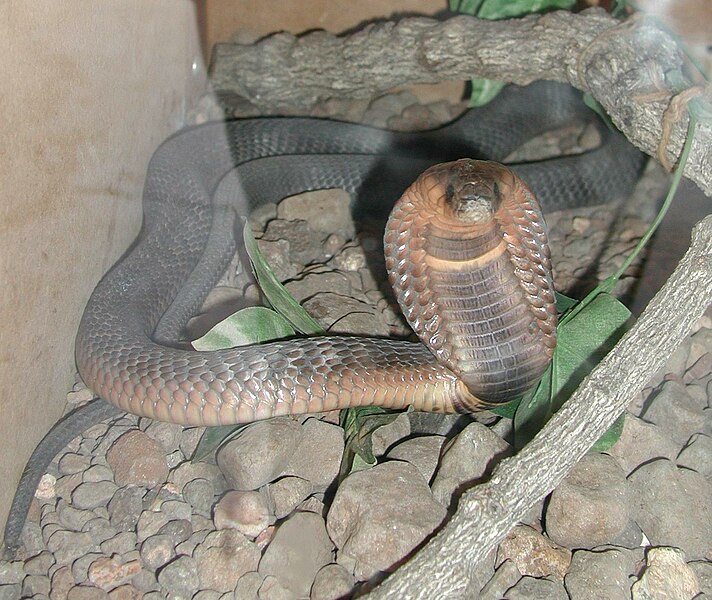
Overview
This week I’ll cover an animal that is not (thankfully!) a pet trade species but which has long inspired awe in reptile enthusiasts and “regular people” alike – the king cobra, largest and arguably most intelligent of the venomous snakes. Please see my note –
A Close Call with a King Cobra, as well.
Physical Description
The king cobra is the world’s longest venomous snake, and may exceed 18 feet in length (average length is 12-15 feet).
Its color and pattern varies greatly across the huge range, with unique color morphs being distinctive of certain geographic areas: specimens from Southeast Asia are usually a uniform olive or yellowish-olive in color, while those originating in India tend to be olive with yellow bands and a black tail. Chinese specimens are often dark brown or black, and banded with white, brown or yellow.
Range and Habitat
This snake’s enormous range extends from northern India through Myanmar, Bangladesh and Cambodia to southeastern China (including Hong Kong and Hainan) and south through Laos, Thailand, Vietnam and much of Indonesia (Sumatra, Java, Borneo, Sulawesi) to western Malaysia and the Philippines.
King cobras occupy a wide variety of habitats but are usually found near a permanent water source. They occur in rainforests, dry forests, lightly wooded areas, overgrown fields, bamboo thickets, mangrove swamps, agricultural areas and along the outskirts of towns.
Status in the Wild
Not well studied. King cobras adapt to some disturbance and often frequent farms in search of other snakes (the favored prey) that are drawn there by rodents. Listed on Appendix II of CITES.
Diet
The king cobra feeds almost exclusively upon other snakes, although lizards are occasionally taken (the Greek-derived Genus name means “Snake-eater”). It hunts by day and actively searches for prey. Keen sighted and quick, king cobras are well-suited to pursuing fast-moving snakes.
In zoos, hatchlings and wild-caught adults often refuse all but snakes as food. Reptile keepers resolve this problem by “scenting” mice and rats (the snakes thrive on a rodent-based diet) with dead snakes that are kept frozen for this purpose. Usually, rubbing a snake on the rodent does the trick. Particularly choosy cobras sometimes force us to become resourceful – boiling a piece of an expired snake in water and soaking the rodent therein is the standard method used in these cases. Most king cobras can eventually be weaned onto a diet of non-scented rodents.
“Scenting” is used to induce other serpentine food specialists to accept alien food items as well. Eastern hog nosed snakes, Heterodon platirhinos, for example, are confirmed toad-eaters but eagerly take toad-scented mice.
Reproduction
King cobras are the only snakes known to construct a nest for their eggs. Using loops of her body, the female scrapes together a pile of rotting leaves and other vegetation, into which the eggs are deposited. Some construct a two-chambered nest, with the upper chamber serving as retreat for the female, while others merely coil on top of the leaf pile.
The female guards her 20-60 eggs for the 60-80 day incubation period. There is some evidence of mate fidelity that the male may also remain in the vicinity of the nest, but this has not been accurately documented.
The hatchlings are 18-22 inches in length and differ markedly from the adults, being boldly striped in black and white.
Check back on Friday to read the rest of this article.
 A 2,000 year-old-legend holds that Cleopatra, famed last Queen of Egypt, committed suicide by allowing an Asp, or Egyptian Cobra (Naja haje), to bite her. A recent study at Germany’s University of Trier, however, has now called this story into question.
A 2,000 year-old-legend holds that Cleopatra, famed last Queen of Egypt, committed suicide by allowing an Asp, or Egyptian Cobra (Naja haje), to bite her. A recent study at Germany’s University of Trier, however, has now called this story into question. That Reptile Blog – Reptile, Amphibian and Exotic Pet Care and Information
That Reptile Blog – Reptile, Amphibian and Exotic Pet Care and Information

